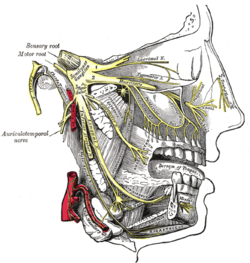Structure and Origin of the Inferior Alveolar Nerve
- The inferior alveolar nerve arises from the mandibular nerve.
- It passes posterior to the lateral pterygoid muscle.
- The nerve enters the mandibular foramen.
- It travels through the mandibular canal within the mandible.
- The nerve splits into its two terminal branches: the mental nerve and the incisive branch.
- It branches from the mandibular nerve before entering the mandibular foramen.
- The nerve originates from the mandibular canal within the mandible.
- It provides sensory branches for the molar and second premolar teeth.
- The nerve terminates near the second lower premolar.
Branches and Distribution of the Inferior Alveolar Nerve
- The mental nerve emerges from the mandibular canal through the mental foramen.
- It provides sensory innervation to the chin and lower lip.
- The incisive branch represents the anterior continuation of the inferior alveolar nerve.
- It courses within the mandible in the mandibular incisive canal.
- The incisive branch provides sensory innervation to the lower premolar, canine, and incisor teeth.
- The inferior alveolar nerves supply sensation to the lower teeth.
- The mental nerve provides sensation to the chin and lower lip.
- The mylohyoid nerve is a motor nerve supplying the mylohyoid and the anterior belly of the digastric.
- The inferior dental plexus gives off small gingival and dental nerves to the molar and second premolar teeth.
- The nerve branches form the inferior dental plexus before providing sensory innervation to the teeth.
Clinical Significance and Complications of Inferior Alveolar Nerve Injuries
- Inferior alveolar nerve injuries commonly occur during dental procedures.
- Trauma and mandibular fractures can also lead to inferior alveolar nerve injuries.
- Trigeminal sensory nerve injuries result in numbness, pain, and altered sensation.
- Wisdom tooth surgery carries a risk of temporary or permanent nerve injury.
- Preoperative warnings and careful extraction techniques can minimize the risk of nerve injury.
- Orthodontic treatment can lead to inferior alveolar nerve damage.
- A systematic scoping review highlighted the need for further research in this area.
- Preoperative use of ibuprofen and meloxicam has been studied for its efficacy in reducing the risk of inferior alveolar nerve damage during dental procedures.
Trigeminal Nerve Damage and Anatomy
- Trigeminal nerve damage can result in post-implant neuropathy.
- A case series documented cases of trigeminal nerve damage associated with peripheral nerve block.
- The Royal College of Anaesthetists provides information for patients about nerve damage associated with peripheral nerve block.
- Nerve damage can be a potential complication of orthodontic treatment.
- The trigeminal nerve is a cranial nerve responsible for sensory information in the face.
- The trigeminal nerve consists of three divisions: ophthalmic, maxillary, and mandibular.
- Detailed anatomy figures of the trigeminal nerve can be found online.
- Understanding the anatomy of the trigeminal nerve is crucial in preventing nerve damage during dental procedures.
Complications of Peripheral Nerve Block and Resources for Patient Information
- Peripheral nerve block can result in nerve damage.
- Post-implant neuropathy is a potential complication of peripheral nerve block.
- The risk of nerve damage during peripheral nerve block should be carefully considered.
- Patients should be informed about the potential complications associated with peripheral nerve block.
- Research and guidelines are available to help reduce the risk of nerve damage during peripheral nerve block.
- Resources like the Royal College of Anaesthetists and Egton Medical Information Systems Limited offer information for patients about nerve damage associated with peripheral nerve block.
- Patients can access resources like the British Dental Journal and the International Dental Journal to learn about cases and studies related to nerve damage.
- Online resources, such as anatomy figures and educational websites, can provide additional information on nerve anatomy and related topics.
The inferior alveolar nerve (IAN) (also the inferior dental nerve) is a sensory[contradictory] branch of the mandibular nerve (CN V3) (which is itself the third branch of the trigeminal nerve (CN V)). The nerve provides sensory innervation to the lower/mandibular teeth and their corresponding gingiva as well as a small area of the face (via its mental nerve).
| Inferior alveolar nerve | |
|---|---|
 Distribution of the maxillary and mandibular nerves, and the submaxillary ganglion. (Inferior alveolar visible at center left.) | |
 Mandibular division of the trigeminal nerve. (Inferior alveolar labeled at bottom right.) | |
| Details | |
| From | mandibular nerve |
| To | mylohyoid, dental, incisive, and mental |
| Innervates | dental alveolus |
| Identifiers | |
| Latin | nervus alveolaris inferior |
| TA98 | A14.2.01.089 |
| TA2 | 6274 |
| FMA | 53243 |
| Anatomical terms of neuroanatomy | |
inferior alveolar nerve (plural inferior alveolar nerves)